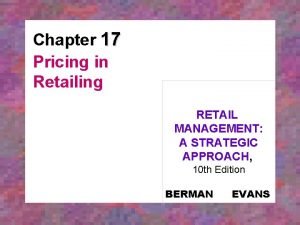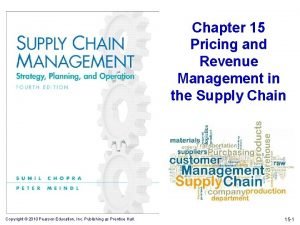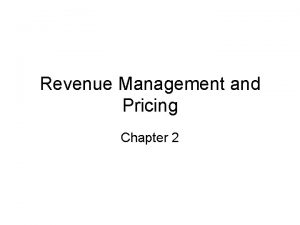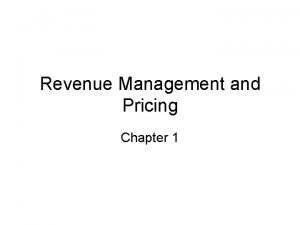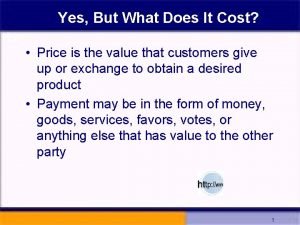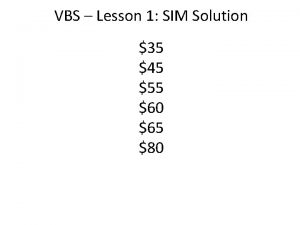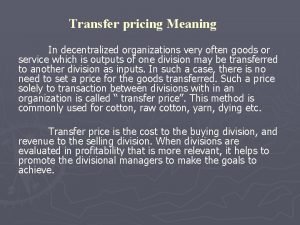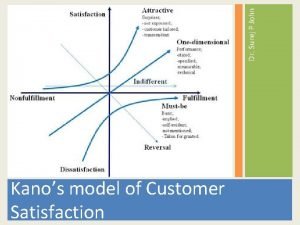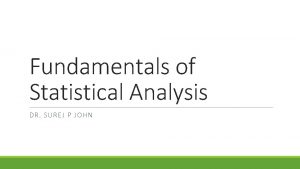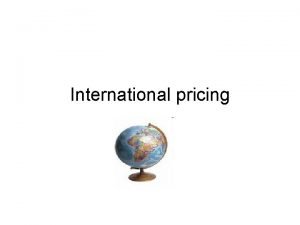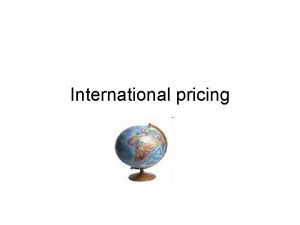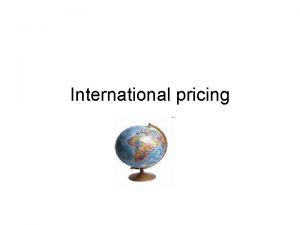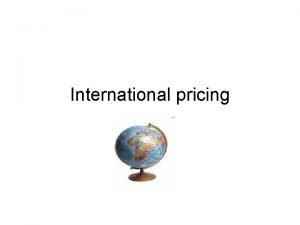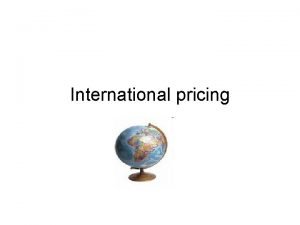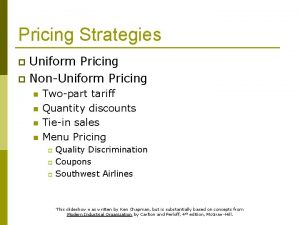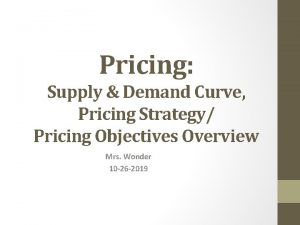Chapter1 Effective Pricing Management 1 Surej P John




























- Slides: 28

Chapter-1 Effective Pricing Management 1 Surej P John 1/2011

The Definition of Price (P. 5) A formal ratio indicating the quantities of money (or goods and services) needed to acquire a given quantity of goods or services. Price = Quantity of money or goods and services received by the seller Quantity of goods and services received by the buyer

Pricing Terms • Rate • Admission • Fees • User fees • Premiums • Min. required balances • Tuition • Fares • Interest charges • Tolls • Tariffs • Duties 03 (P. 5) Pricing

The Role of Prices determine what products and services should be produced and in what amounts. n Prices determine how these products and services should be produced. n Prices determine for whom the products and services should be produced. n 4

Figure 1. 1 Conceptual Orientation to Pricing (P. 12) Demand factors (Value to buyers) (Price ceiling) Competitive factors Final pricing discretion Corporate objectives & Regulatory constraints Direct variable costs (Price floor) Initial pricing discretion

Ways to Change Price Change the quantity of money or goods and services to be paid by the buyer n 6

Ways to Change Price Change the quantity of goods and services to be provided by the seller n 7

Ways to Change Price Change the quality of goods and services provided n 8

More Ways to Change Price Change the premiums or discounts to be applied for quantity reasons. n. Change the place and time of payment. n 9

More Ways to Change Price Change the time and place of transfer of ownership. Change the acceptable form of payment. 10

Importance of Pricing Decisions By 1994, pricing was viewed as the major pressure point for managerial decision making. The various environmental pressures are as follows: ØFaster technological progress ØProliferation of new products ØIncreased demand for services ØIncreased global competition ØThe changing legal environment 11

Faster Technological Progress Has… Reduced the gap between invention and innovation Reduced the average of products Demand for many goods and services is more sensitive to relative prices and shifts in prices. 12

Proliferation of New Products n “Population explosion” of new products Product lines have widened n. Blurred market segments n Small price differentials may produce relatively large shifts in demand n 13

Increased Demand for Services Increase in demand for services has led to an increase in prices, which have led to public concern and governmental activity There is also an increase in demand for services built into products 14

Increased Global Competition Increased foreign trade around the world has increased the amount of price competition faced by domestic producers 15

The Changing Legal Environment Deregulation and privatization of companies have resulted in more complex, more difficult, and more important pricing decisions 16

Economic Uncertainty Slowed or stopped inflation rates in other countries’ economies has led to the need for new approaches to developing pricing strategies 17

Five Factors to Consider in Pricing Demand Costs Competitive factors Corporate profit and market objectives Regulatory constraints 18

Demand Implications Market versus product elasticity Price elasticity of demand is a measure of the degree to which buyers are sensitive to price changes. For any functionally substitutable products, there actually two demand schedules 1. Primary demand- The demand for the general product category 2. Secondary demand- Demand for the firm’s specific offering Generally Secondary demand is more responsive to price changes 19

Demand Implications Derived demand for buyer’s output Many businesses sell their products and services to other businesses, which perform additional value added processing before selling their output to final buyers. 20

Demand Implications Likelihood of competitive entry ØHigh price strategies may encourage the entry of competitors when entry barriers are low and when the demand is price elastic. ØThus buyers may quickly accept a new competitors product because of the high prices. 21

The Three Levels of Pricing Management 1. Understanding the economic and competitive environment Factors that influence supply and demand 2. Developing product and market pricing strategy Benefits, costs, and prices 3. Administering the pricing process Tactical pricing decisions 23

Level One 1. Traditional Economic How will current and future supply and demand dynamics affect overall market price levels? Economic/market environment Changes in competition, supply, capacity Shifts in demand New product developments 24

Level Two 2. Product and Market Strategy Within each market segment, what is the correct list or target price for each product? Customers’ perceptions of price and value Price research Profitability analysis Pricing strategy 25

Level Three 3. Price Structure Management How to determine the actual price to receive from each transaction? Organizing for price administration Transaction management: setting discounts, allowances, rebates… Establishing pricing tactics Maintaining feedback and control Legal and ethical issues 26

Tactical Pricing Decisions Tactical pricing decisions concern day-to-day management of the pricing function, including: Timing of price changes Amount of price changes Direction of price changes Administering price changes Communicating price changes to sales force customers 27

END OF CHAPTER 1 28

Class Assignment Read case given at BOX 1. 1 and answer the following questions 1. How did Frito Lay change the price of its salty snack products? 2. How do you comment on “ Weight out” issue raised in this case? 29
 Chapter 1 of mice and men
Chapter 1 of mice and men Revelation chapter 1-3 summary
Revelation chapter 1-3 summary Dmd chapter
Dmd chapter Pricing strategies in retail management
Pricing strategies in retail management Role of pricing and revenue management in a supply chain
Role of pricing and revenue management in a supply chain Role of pricing and revenue management in a supply chain
Role of pricing and revenue management in a supply chain Price adjustment in retail management
Price adjustment in retail management Pricing decision and cost management
Pricing decision and cost management Revenue management and pricing
Revenue management and pricing Pricing and revenue management in supply chain
Pricing and revenue management in supply chain The management spectrum (3 p’s) are
The management spectrum (3 p’s) are Effective small business management
Effective small business management Steps in portfolio management
Steps in portfolio management Classroom management elements
Classroom management elements Effective management techniques
Effective management techniques Basic principles of effective portfolio management
Basic principles of effective portfolio management Top management and middle management
Top management and middle management Top management middle management first line management
Top management middle management first line management Middle level management
Middle level management John r. schermerhorn jr. management
John r. schermerhorn jr. management Introduction to hospitality 7th edition
Introduction to hospitality 7th edition Tourism the business of hospitality and travel 5th edition
Tourism the business of hospitality and travel 5th edition John r. schermerhorn jr. management
John r. schermerhorn jr. management John r walker introduction to hospitality management
John r walker introduction to hospitality management Captive pricing
Captive pricing Knowledge matters parking sim answers
Knowledge matters parking sim answers Ltl blanket pricing
Ltl blanket pricing Transfer price meaning
Transfer price meaning Transfer pricing example
Transfer pricing example



